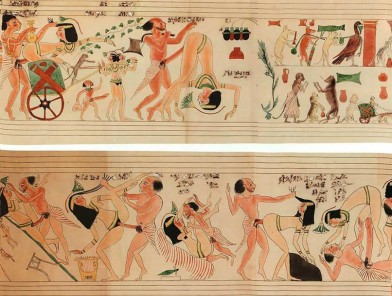Romance and Human Connection Along the Nile
When people picture Ancient Egypt, they often imagine pyramids, pharaohs, and golden treasures buried deep in the desert. Yet behind the monumental architecture was a society deeply concerned with the same emotions we feel today longing, passion, loyalty, and betrayal. Marriage was both a contract and a relationship, where family security came first but affection and attraction were never dismissed. Poetry inscribed on papyrus described stolen glances, whispered desires, and the overwhelming power of love. Even in the heart of a civilization thousands of years old, intimacy remained one of the most powerful driving forces of daily life.
The Role of Marriage in Daily Society
For ordinary people, unions were built on stability, inheritance, and maintaining family ties. Couples married young, sometimes in their teenage years, and partnerships were expected to last through the trials of everyday living. Yet the Egyptians were not cold or indifferent emotional connection and tenderness appeared in art, literature, and private writings. Husbands praised their wives’ beauty, while women celebrated their partners in songs filled with playful flirtation. This balance of practicality and passion reveals just how much importance Egyptians placed on the bonds of companionship.
Fertility, Rituals, and Sacred Traditions
Few aspects of life carried as much symbolic weight as fertility. Children were seen as blessings from the gods, proof of a healthy union, and the continuation of family heritage. Couples who struggled to conceive turned to herbal remedies, ritual prayers, and amulets shaped like sacred animals to call upon divine assistance. Deities such as Hathor, Isis, and Min were honored in temples where prayers for pregnancy were whispered beneath flickering oil lamps. These practices might seem strange today, but for Egyptians, fertility was a matter of both spiritual duty and personal fulfillment.
Blending Medicine and Magic
What makes this civilization particularly fascinating is how seamlessly it combined medical knowledge with mystical beliefs. Papyrus scrolls describe unusual diagnostic techniques, like inserting garlic or onion as a fertility test to determine whether a woman could conceive. Remedies were prepared using honey, herbs, and minerals, reflecting an early form of natural medicine intertwined with sacred ritual. To the Egyptians, there was no contradiction between science and spirituality they were simply two sides of the same mystery of life.
Gods, Goddesses, and the Power of Myth
Mythology played a central role in shaping Egyptian attitudes toward desire and connection. The legendary love story of Isis and Osiris illustrated devotion and rebirth, while the cosmic union of Nut and Geb, sky and earth, symbolized the creation of life itself. Stories of divine jealousy, betrayal, and seduction echoed the very real emotions humans experienced every day. These myths gave cultural legitimacy to intimacy, showing that even the gods were bound by passion.
Royal Families and Controversial Practices
The royal household lived by a different set of rules. Pharaohs often married within their own family, sometimes even sisters or half-sisters, to maintain dynastic power and strengthen their connection to divine ancestry. While this practice may seem shocking today, at the time it symbolized purity and legitimacy. Yet palace life was far from serene—ancient texts reveal jealousy, affairs, and scandals that would not feel out of place in a modern drama. For all their godlike status, pharaohs were still human, vulnerable to the same emotions as the people they ruled.
Expressions of Desire in Art and Literature
Love poems and erotic imagery were far from hidden in Egyptian culture. Verses inscribed on pottery spoke of longing and playful affection, while murals depicted sensual embraces. Figurines and ornaments often carried subtle undertones of attraction, reminding us that the Egyptians embraced beauty and desire without shame. These cultural artifacts show that intimacy was not merely tolerated but celebrated, woven into the fabric of their daily lives.
Perfume, Beauty, and Seduction Rituals
Physical attraction was heightened by the use of oils, perfumes, and cosmetics. Women painted their eyes with black kohl not only for aesthetic reasons but also as part of the art of seduction. Fragrant oils were massaged into skin, creating moments where touch, scent, and emotion became inseparable. Grooming and appearance played a key role in relationships, with beauty viewed as both divine and deeply human. Egyptians understood that seduction was not just physical it was also spiritual, emotional, and artistic.
Contraception and Intimate Health
Interestingly, Egyptian society also experimented with methods to prevent pregnancy. Ancient writings describe mixtures of honey and even crocodile dung as forms of contraception, reflecting the resourcefulness and creativity of a people determined to control their intimate lives. While these methods may sound unusual today, they show an openness to discussing and addressing reproductive health rarely seen in later cultures. For Egyptians, intimacy was not taboo it was a natural subject to be studied, debated, and integrated into everyday life.
Jealousy and Human Emotion
Love and desire were celebrated, but they also came with their darker sides. Jealousy and betrayal were recurring themes in both mythology and everyday records. Poems spoke of heartbreak, legal documents preserved the fallout of affairs, and stories of envy reminded people of the risks that came with passion. These records make it clear that Egyptians were not idealized beings; they were flawed, emotional, and driven by the same complicated feelings that shape relationships today.
Why Ancient Egyptian Intimacy Still Resonates
What makes these stories timeless is their familiarity. Thousands of years later, we can still relate to the hopes, fears, and passions that animated lives along the Nile. Egyptians loved, desired, envied, and dreamed just as we do now. Their world may have been filled with temples, tombs, and rituals, but their emotional lives were deeply human. By studying their customs, we are reminded that history is not just about kings and battles it is also about love, connection, and the universal search for intimacy.
